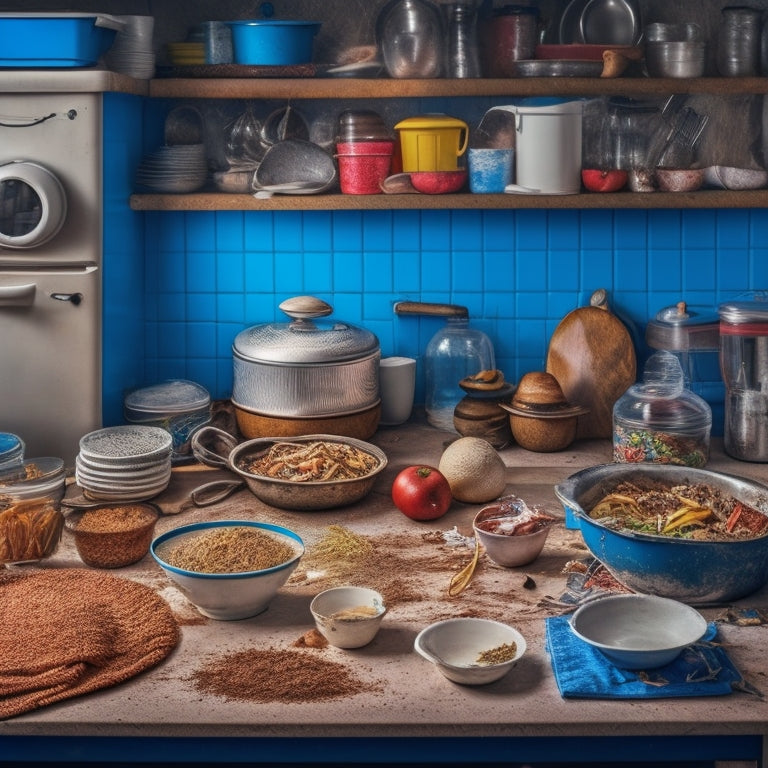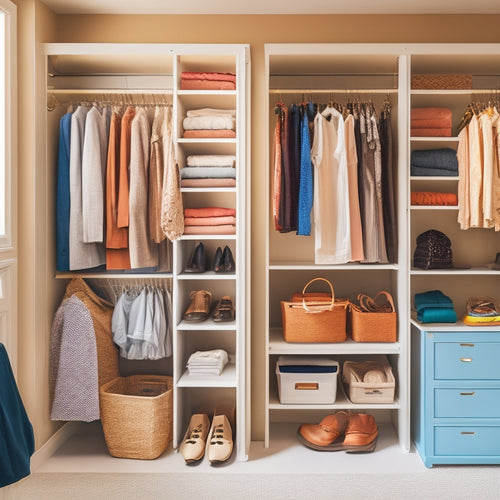
What's Hiding in Your Cluttered Kitchen?
Share
Your cluttered kitchen is hiding more than just dirty dishes and expired ingredients - it's also concealing unseen dangers that can compromise your health, increase stress, and decrease cooking efficiency. Pests like cockroaches and rodents thrive in disorganized spaces, contaminating food and surfaces. Cluttered kitchens also lead to reduced time management, chaotic family interactions, and heightened stress levels during cooking. But, by recognizing these hazards, you've taken the first step towards a safer, more efficient, and more enjoyable cooking experience. As you investigate the secrets hiding in your kitchen, you'll uncover surprising ways to change the heart of your home.
Key Takeaways
- Cluttered kitchens harbor hidden dangers, including health risks, pest infestations, and elevated stress levels during cooking.
- Disorganized spaces lead to reduced time management, affecting overall cooking efficiency and family interactions during mealtime.
- A cluttered kitchen can hide expired or spoiled food, broken appliances, and forgotten gadgets.
- Clutter can conceal areas that need deep cleaning, creating an environment conducive to pests and germs.
- A clutter-free kitchen reveals a more efficient, organized, and stress-free cooking environment, promoting better mealtime experiences.
Hidden Dangers of Kitchen Clutter
When you're cooking up a storm in your kitchen, it's easy to overlook the subtle yet insidious dangers lurking beneath the surface of cluttered countertops and overflowing shelves.
Cluttered kitchens pose significant health risks, compromising food safety by creating an ideal environment for pests to thrive. Furthermore, cluttered spaces lead to increased stress levels, decreased time management, and reduced cooking efficiency.
By implementing a digital detox and adopting a one in, one out policy, you'll be more mindful of the items you bring into your kitchen. A cluttered kitchen can also negatively impact family interactions, making mealtime a chaotic experience.
Maximizing Counter Space Efficiently
You're probably tired of feeling like you constantly juggling pots, pans, and utensils on your kitchen counters.
To maximize your counter space efficiently, you need to clear the clutter and optimize your layout.
Clear the Clutter
Your kitchen counters are a breeding ground for clutter, with appliances, utensils, and ingredients competing for space. To regain control, adopt a minimalist approach to kitchen organization.
Start by clearing everything off your countertops and sorting items into categories. Be ruthless – if you haven't used it in the past year, consider letting it go.
Designate a home for each item, and make sure it's easily accessible. Keep frequently used items front and center, and store less-used items in designated zones.
Optimize Your Layout
By maximizing counter space efficiently, you'll create a seamless workflow that makes cooking and cleaning a breeze. This is where kitchen ergonomics comes into play, ensuring your layout flow is optimized for your needs. Consider the "golden triangle" concept, where your sink, stove, and refrigerator form the points of a triangle to reduce walking distances.
| Zone | Function | Ideal Placement |
|---|---|---|
| Prep | Chopping, dicing | Near sink, with easy access to trash |
| Cook | Stovetop, oven | Adjacent to prep zone, with utensils nearby |
| Clean | Sink, dishwasher | Near prep zone, with soap and towels handy |
Taming the Kitchen Junk Drawer
You've conquered the countertops, but now it's time to tackle the kitchen's most notorious clutter collector: the junk drawer.
Sorting out the chaos within requires a strategic approach, and you'll need to get ruthless about what stays and what goes.
Sorting Out the Chaos
Chaos reigns supreme in the kitchen junk drawer, where tangled cords, crumpled receipts, and expired coupons converge in a jumbled mess.
You're not alone in this struggle, but it's time to take control. Start by emptying the drawer and sorting items into categories, such as "keep," "donate," and "recycle."
Implement a kitchen organization system that works for you, like a container system with labeled bins. Designate a spot for frequently used items, like a utensil organizer or a cord keeper.
Be ruthless – if you haven't used it in the past year, it's likely you won't miss it.
Decluttering Hidden Spaces
The kitchen junk drawer, a notorious catch-all for miscellaneous items, is often the most cluttered and overwhelming space in the kitchen.
You're not alone if you've lost track of what's hiding in there. It's time to tame this beast and uncover the hidden storage potential within.
Start by emptying the drawer and sorting items into categories. Be ruthless – get rid of anything broken, expired, or unnecessary.
Consider using dividers or bins to create separate spaces for utensils, batteries, and other small items.
You might be surprised to find forgotten appliances or gadgets that can be repurposed or donated.
Streamlining Your Kitchen Workflow
One key aspect of maintaining a clutter-free kitchen is streamlining your kitchen workflow, which involves optimizing the way you prepare, cook, and clean up meals.
By doing so, you'll be able to cook more efficiently, reduce stress, and enjoy the process of cooking.
To achieve this, focus on the following:
-
Designate a meal prep zone: Allocate a specific area for meal prep, such as a countertop or island, to keep all necessary tools and ingredients within reach.
-
Implement a cooking station: Organize your cooking utensils and ingredients by category, making it easier to access what you need when you need it.
-
Optimize your cleaning routine: Clean as you go to avoid a huge mess at the end of the meal, and designate a specific area for cleaning supplies.
- Prioritize cooking efficiency: Plan your meals in advance, prep ingredients, and cook in bulk to reduce cooking time and increase productivity.
Decluttering Kitchen Cabinets Quickly
You're likely no stranger to digging through cluttered kitchen cabinets, searching for that one elusive spice or kitchen gadget. It's frustrating and wasted time you can't afford.
To declutter your kitchen cabinets quickly, start by removing everything and sorting items into three piles: keep, donate/sell, and discard. Be ruthless – if you haven't used it in the past year, it's likely not a kitchen essential.
Adopt a minimalist approach, keeping only what you truly need or use regularly. Store items in categories, such as baking supplies or cooking utensils, to make them easy to find.
Creative Storage for Small Kitchens
Five small kitchen essentials - a toaster, blender, coffee maker, stand mixer, and slow cooker - can quickly clutter countertops.
To reclaim your space, think vertically and multifunctionally.
-
Install a pegboard on a wall or the back of a door to hang frequently used items like pots, pans, and utensils.
-
Invest in a cart or island with built-in storage, such as drawers, shelves, or cabinets.
-
Choose a microwave with a range hood to maximize vertical storage.
- Select a kitchen table with built-in storage, like a pedestal with shelves or a bench with cabinets.
Frequently Asked Questions
How Do I Declutter Sentimental Kitchen Items Without Feeling Guilty?
Did you know 62% of people hold onto items due to emotional attachment? You're not alone! To declutter sentimental kitchen items without guilt, take photos of nostalgic recipes, preserve memories digitally, and let go of duplicates, keeping only what sparks joy, freeing up space and your mind.
Can a Cluttered Kitchen Affect My Mental and Physical Health?
You're right to wonder: a cluttered kitchen can indeed affect your mental and physical health, leading to kitchen stress that clouds your mental clarity, making it harder to focus and make healthy choices, and even sparking anxiety and fatigue.
What Are Some Eco-Friendly Ways to Dispose of Kitchen Waste?
Did you know 30% of waste is recyclable? You can take control by adopting eco-friendly habits: implement composting methods like vermicomposting or bokashi, and follow recycling tips like separating paper from plastic to reduce your kitchen's environmental footprint.
How Often Should I Clean and Organize My Kitchen Appliances?
You should clean and organize your kitchen appliances regularly, ideally every 1-3 months, and implement a seasonal cleaning schedule to guarantee appliance maintenance tips are met, keeping your kitchen efficient and hygienic.
Can a Kitchen's Layout Impact My Cooking Skills and Confidence?
A million tiny frustrations await you in a poorly designed kitchen, but optimizing your layout can be a total breakthrough! By prioritizing kitchen ergonomics and workflow optimization, you'll cook with confidence, whipping up meals like a pro in no time!
Related Posts
-

Simplify Your Digital Life in 5 Easy Steps
You're tired of feeling suffocated by digital clutter, stuck in a never-ending cycle of notifications, file disorgani...
-

Free Printable Closet Organization Checklists for Success
You're ready to tackle your closet clutter and create a peaceful space that sparks joy. A free printable closet organ...
-

Clear Digital Clutter for a Peaceful Mind
You're tired of feeling anxious and mentally fatigued, but do you know that your cluttered digital space is a major c...


